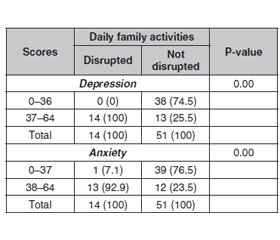Журнал «Здоровье ребенка» Том 20, №4, 2025
Вернуться к номеру
Вплив повсякденної сімейної активності на депресію, тривогу та якість життя в дітей із харчовою алергією
Авторы: M. Syahrezki (1), A.M. Putera (1, 2), Irwanto (1, 2)
(1) - Faculty of Medicine, Airlangga University, Surabaya, Indonesia
(2) - Dr. Soetomo General Academic Hospital, Surabaya, Indonesia
Рубрики: Педиатрия/Неонатология
Разделы: Клинические исследования
Версия для печати
Актуальність. Харчова алергія є хронічним захворюванням, її поширеність в Азії становить 3,4–11,1 %. Через обмежену доступність етіотропного лікування основним методом залишається уникнення алергенів. Це може призводити до обмежень і порушення активності дітей та їхніх родин, спричиняючи психосоціальні проблеми в усіх. Матеріали та методи. Проведено обсерваційне поперечне дослідження за участю дітей віком 7–17 років із харчовою алергією, яких спостерігали в педіатричній алергологічній клініці медичного закладу Dr. Soetomo General Hospital (Сурабая, Індонезія). Кожен учасник заповнив опитувальники PedsQL, RCADS та FAIS. Для оцінки впливу змінних проведено логістичний регресійний аналіз з використанням програми SPSS (версія 23.0); значущими вважали результати при p < 0,05. Результати. Загалом у дослідженні взяли участь 65 респондентів. Чотирнадцять пацієнтів (21,5 %) зазнали порушень у повсякденній сімейній активності. Результати логістичного регресійного аналізу зв’язку між щоденними сімейними зайняттями, депресією і тривогою були статистично вірогідні: p = 0,00 для депресії та тривоги. Аналіз також продемонстрував, що повсякденна сімейна активність і тривога мали статистично значущий вплив на якість життя (p = 0,00 та 0,01 відповідно), тоді як вплив депресії був незначним (p = 1,234). Висновки. Повсякденна сімейна активність вірогідно впливає на депресію, тривогу та якість життя в дітей із харчовою алергією.
Background. Food allergy is a chronic disease with a prevalence of 3.4–11.1 % in Asia. The limited availability of causative treatments means that the primary management approach is avoidance, which can lead to restrictions and disruptions in the activities of children and their families, potentially causing psychosocial problems for both the family and the child. Materials and methods. This was an observational cross-sectional study conducted on children aged 7–17 years with food allergies at the pediatric allergy clinic of the Dr. Soetomo General Hospital, Surabaya. Each subject completed the PedsQL, RCADS, and FAIS questionnaires. Logistic regression analysis was conducted using SPSS version 23.0 to assess the impact of variables, with p < 0.05 considered statistically significant. Results. A total of 65 children met the inclusion and exclusion criteria and participated in the study. Fourteen patients (21.5 %) experienced disruptions in daily family activities. Logistic regression analysis of the correlation of daily family activities with depression and anxiety revealed significant results, with p = 0.00 for both depression and anxiety. The analysis demonstrated that daily family activities and anxiety had a statistically significant impact on quality of life (p = 0.00 and 0.01, respectively), whereas the influence of depression was not significant (p = 1.234). Conclusions. Daily family activities significantly impact depression, anxiety, and quality of life in children with food allergies.
харчова алергія; депресія; тривога; якість життя
food allergy; depression; anxiety; quality of life

